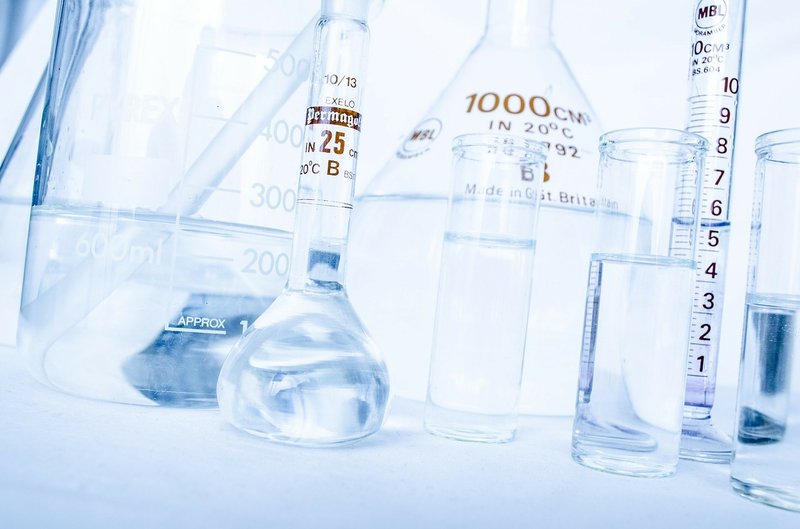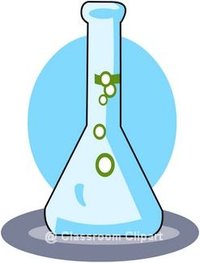Chemistry
|
|
Chemistry is the science of matter and its interactions with energy and itself (see physics, biology). Because of the diversity of matter, which is mostly in the form of atoms, chemists often study how atoms interact to form molecules and how molecules interact with each other.
| Contents |
Subdisciplines of chemistry
Chemistry typically is divided into several major sub-disciplines. There are also several main cross-disciplinary and more specialized fields of chemistry.
- Analytical chemistry
- Analytical chemistry is the analysis of material samples to gain an understanding of their chemical composition and structure.
- Biochemistry
- Biochemistry is the study of the chemicals, chemical reactions and chemical interactions that take place in living organisms.
- Inorganic chemistry
- Inorganic chemistry is the study of the properties and reactions of inorganic compounds. The distinction between organic and inorganic disciplines is not absolute and there is much overlap, most importantly in the sub-discipline of organometallic chemistry.
- Organic chemistry
- Organic chemistry is the study of the structure, properties, composition, and reactions of organic compounds.
- Physical chemistry
- Physical chemistry is the study of the physical basis of chemical systems and processes. In particular, the energetic description of diverse chemical transformations are of interest to physical chemists. Important areas of study include chemical thermodynamics, chemical kinetics, quantum chemistry, statistical mechanics, and spectroscopy.
- Other fields
- Astrochemistry, Atmospheric chemistry, Chemical Engineering, Computational Chemistry, Electrochemistry, Environmental chemistry, Geochemistry, History of chemistry, Materials science, Medicinal chemistry, Molecular Biology, Nuclear chemistry, Organometallic chemistry, Petrochemistry, Pharmacology, Photochemistry, Polymer chemistry, Supramolecular chemistry, Surface chemistry, and Thermochemistry.
Fundamental concepts
Nomenclature
Nomenclature refers to the system for naming chemical compounds. There are well-defined systems in place for naming chemical species. Organic compounds are named according to the organic nomenclature system. Inorganic compounds are named according to the inorganic nomenclature system. IUPAC nomenclature
Atoms
An atom is a collection of matter consisting of a positively charged core (the nucleus) which usually contains protons and neutrons, and which maintains a number of electrons to balance the positive charge in the nucleus.
Elements
An Chemical element is a class of atoms which have the same number of protons in the nucleus. This number is known as the atomic number of the element. For example, all atoms with 6 protons in their nuclei are atoms of the chemical element carbon, and all atoms with 92 protons in their nuclei are atoms of the element uranium.
The most convenient presentation of the elements is in the periodic table, which groups elements with similar chemical properties together. Lists of the elements by name, by symbol, and by atomic number are also available.
Because the number of protons in the nucleus dictates the number of electrons surrounding the nucleus and their properties, and because the electrons are the outermost component of atoms (the component which 'sees' the rest of the universe), the identity of an element dictates the interactions, or chemical transformations, in which it can participate. There may, however, be subtle changes in chemical properties brought about by the number of neutrons in the nucleus of otherwise "same" elements.
Compounds
A Chemical compound is a substance with a fixed ratio of elements which determines the composition, and a particular organization which determines chemical properties. For example, water is a compound containing hydrogen and oxygen in the ratio of two to one. Compounds are formed and interconverted by chemical reactions.
Molecules
A molecule is the smallest indivisible portion of a pure compound that retains a set of unique chemical properties. A molecule consists of two or more atoms bonded together.
Ions
An Ion is a charged species, or an atom or a molecule that has lost or gained an electron. Positively charged cations (e.g. sodium cation Na+) and negatively charged anions (e.g. chloride Cl-) build neutral salts (e.g. sodium chloride NaCl). Examples of polyatomic ions that do not split up during acid-base reactions are hydroxide (OH-), or phosphate (PO43-).
Bonding
A Chemical bond is the force which holds together atoms in molecules or crystals. In many simple compounds, valence bond theory and the concept of oxidation number can be used to predict molecular structure and composition. Similarly, theories from classical physics can be used to predict many ionic structures. With more complicated compounds, such as metal complexes, valence bond theory fails and alternative approaches which are based on quantum mechanics, such as molecular orbital theory, are necessary.
States of matter
A Phase (matter) is a set of states of a chemical system that have similar bulk structural properties, over a range of conditions, such as pressure or temperature. Physical properties, such as density and refractive index tend to fall within values characteristic of the phase. The phase of matter is defined by the phase transition, which is when energy put into or taken out of the system goes into rearranging the structure of the system, instead of changing the bulk conditions.
Sometimes the distinction between phases can be continuous instead of having a discrete boundary, in this case the matter is considered to be in a supercritical state. When three states meet based on the conditions, it is known as a triple point and since this is invariant, it is a convenient way to define a set of conditions.
The most familiar examples of phases are solids, liquids, and gases. Less familiar phases include plasmas, Bose-Einstein condensates and fermionic condensates and the paramagnetic and ferromagnetic phases of magnetic materials. Even the familiar ice has many different phases, depending on the pressure and temperature of the system. While most familiar phases deal with three-dimensional systems, it is also possible to define analogs in two-dimensional systems, which is getting a lot of attention because of its relevance to biology.
Reactions
Chemical reactions are transformations in the fine structure of molecules. Such reactions can result in molecules attaching to each other to form larger molecules, molecules breaking apart to form two or more smaller molecules, or rearrangements of atoms within or across molecules. Chemical reactions usually involve the making or breaking of chemical bonds.
Quantum theory
Quantum theory describes the behavior of matter at short length scales. It is, in principle, possible to describe all chemical systems using this theory, but it is mathematically complex and profoundly non-intuitive. In practice, only the simplest chemical systems may realistically be investigated in purely quantum mechanical terms, and approximations must be made for most practical purposes (e.g., Hartree-Fock or Density functional theory). Hence a detailed understanding of quantum mechanics is not necessary for most chemistry, as the important implications of the theory (principally the orbital approximation) can be understood and applied in simpler terms.
Laws
The most fundamental concept in chemistry is the law of conservation of mass, which states that there is no detectable change in the quantity of matter during an ordinary chemical reaction. Modern physics shows that it is actually energy that is conserved, and that energy and mass are related; a concept which becomes important in nuclear chemistry. Conservation of energy leads to the important concepts of equilibrium, thermodynamics, and kinetics.
Further laws of chemistry elaborate on the law of conservation of mass. Joseph Proust's law of definite composition says that pure chemicals are composed of elements in a definite formulation; we now know that the structural arrangement of these elements is also important.
Dalton's law of multiple proportions says that these chemicals will present themselves in proportions that are small whole numbers (i.e. 1:2 O:H in water); although for biomacromolecules and mineral chemistry the ratios tend to require large numbers.
More modern laws of chemistry define the relationship between energy and transformations.
- In equilibrium, molecules exist in mixture defined by the transformations possible on the timescale of the equilibrium, and are in a ratio defined by the intrinsic energy of the molecules—the lower the intrinsic energy, the more abundant the molecule.
- Transforming one structure to another requires the input of energy to cross an energy barrier; this can come from the intrinsic energy of the molecules themselves, or from an external source which will generally accelerate transformations. The higher the energy barrier, the slower the transformation occurs.
- There is a hypothetical intermediate, or transition structure, that corresponds to the structure at the top of the energy barrier. The Hammond-Leffler Postulate states that this structure looks most similar to the product or starting material which has intrinsic energy closest to that of the energy barrier. Stabilizing this hypothetical intermediate through chemical interaction is one way to achieve catalysis.
- All chemical processes are reversible (law of microscopic reversibility) although some processes have such an energy bias, they are essentially irreversible.
History of chemistry
- History of chemistry
- Alchemy
- Discovery of the chemical elements
- Timeline of chemical element discovery
- Nobel Prize in chemistry
Clip Art and Pictures
- Chemistry Clipart (http://classroomclipart.com/cgi-bin/kids/imageFolio.cgi?direct=Clipart/Chemistry)
- Science Animations (http://classroomclipart.com/cgi-bin/kids/imageFolio.cgi?direct=Animations/Science)
- Science Pictures and Clipart (http://classroomclipart.com/cgi-bin/kids/imageFolio.cgi?direct=Science)
- Chemistry Pictures (http://classroomclipart.com/cgi-bin/kids/imageFolio.cgi?direct=Science/Chemistry)
Lesson Plans, Resources and Activites
- Chemistry Lesson Plans (http://lessonplancentral.com/lessons/Science/Chemistry/index.htm)
- Creative Chemistry Crosswords (http://www.creative-chemistry.org.uk/funstuff/xword/)
- Coloring Books (http://www.energyquest.ca.gov/games/coloring_books/)
See also
- List of chemistry topics
- Chemist and List of chemists
- American Chemical Society
- International Union of Pure and Applied Chemistry
- Chemical engineering
- Periodic table
- List of compounds
- List of important publications in chemistry
| General subfields within the Natural sciences |
|---|
| Astronomy | Biology | Chemistry | Earth Sciences | Ecology | Physics |




